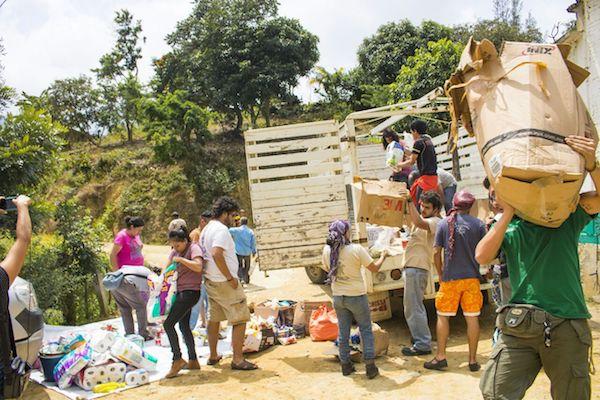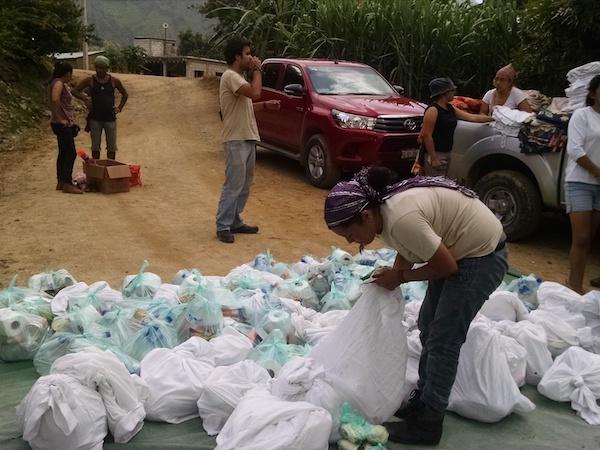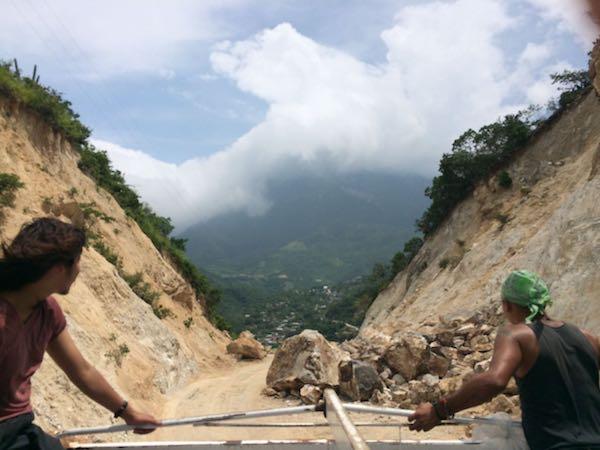
When three major earthquakes struck Mexico in September 2017, the Cimarronez—an autonomous Mexico City-based political collective—organized eight brigadas, or teams, to carry out self-managed reconstruction projects in Oaxaca, Morelos, and Puebla. The most devastating of the earthquakes struck on September 19, measuring a magnitude of 7.1. It left an estimated 370 people dead, more than 6,000 injured, and over 40 collapsed buildings in Mexico City. Just 12 days before, a 8.1 magnitude earthquake had struck Chiapas and Oaxaca, leaving over 100 dead. Four days after the September 19 earthquake, a 6.1 magnitude earthquake struck Oaxaca once again.
Brigadas played an important role in the recovery efforts and often were more effective and efficient than the state’s response efforts, which were primarily focused on upper-class areas of the capital at the expense of poorer areas and were marred by political manipulation. For example, some political parties attempted to leverage influence with the distribution of aid. This is not to mention rural areas of the country, which were often left completely without aid from the government. Furthermore, within Mexico City, the military, with its heavy-handed approach of shutting down volunteer-led rescue operations to raze collapsed building sites, sometimes with people still potentially trapped in the debris, often conflicted with the civil society led response. Brigadas, like those organized by the Cimarronez, filled the gap left by the state. Consisting of both older collective members and those answering their call for volunteers (often students) that circulated on social media, they went to towns and villages that had not seen any government response, organized skill-shares and cultural events, built temporary housing, documented living conditions, and organized temporary clinics. The biggest brigada consisted of 40 people, while smaller ones had around 20.
The Cimarronez, founded in 2010, works to create spaces and economies that provide alternatives to capitalism. As a collective working from the left and from below, they also advocate to recuperate Indigenous languages and cultures. The collective is comprised of 30 members, the majority of whom are women and from working-class and Indigenous backgrounds.
This interview, with two of its members, who wished to remain anonymous and are reffered to as “L” and “C,” took place in their headquarters, a building subdivided into different living and work spaces, currently housing 10 people in eastern Mexico City in January. It was first published in Spanish in Esferas and translated here for the first time.
This interview has been edited for clarity.
First, I would like to discuss the September 7, 19, and 21 earthquakes in Mexico. What was the Cimarronez response and how did you organize after the earthquake to support those affected by it?
C: In the cooperative, we start from the idea that the work we do is with our communities. The September earthquakes marked yet another time our communities have been faced with the damages of a natural disaster. When we went to our Indigenous communities, it wasn’t just with the idea of helping, but also being in solidarity. The hunger, poverty, and marginalization can’t only be attributed to this moment, or the earthquakes, but also to the same conditions we have lived in for the past 500 years. We do not have access to basic things like education or healthcare.
When the earthquakes hit, our duty was to be in solidarity with our communities, but also to build autonomy for them as well. When we went to the Oaxaca, Morelos, and other states, our plan was to collaborate in solidarity with our comrades there.
Why do you think that brigadas are the best way to advance solidarity with the affected communities? How were they organized and what work was done?
C: The brigadas offer a way to work in solidarity with the communitites affected [by the earthquakes], particularly those outside the city. Mexico City is very large and diverse; it provides many possibilities with its resources and economic flows. The cooperative and the brigadas took advantage of these possibilities by collecting economic resources. [After the earthquakes] a much larger flow of people and resources went to Mexico City than to those affected in rural communities. When the first earthquake hit, we went to some of the affected areas in the city, in the city center and the Multifamilar Tlalpan [a large apartment complex of mostly lower-class residents in the south of Mexico City, where a building collapsed and nine people died on September 19.] We worked there for two nights. Once we saw the local population’s response, and that the worst things were being resolved, we decided to go to the Istmo [the southern region of Oaxaca]—a place where no one was directing the recovery efforts.
We began searching for funding and resources to bring with us because we did not have transportation nor materials at the time. Since then, all our work has been thanks to the solidarity efforts of the people who responded to the call we sent out. That’s how we managed to go to [the Istmo]. In general, the eight brigadas have done work based on five different categories: health, culture, communications, production of cacao, and the reconstruction of housing. This work will take years.

L: We want to rebuild houses, but we don’t have the necessary resources. We need an organized group of people on the ground. Our intention is to rebuild the extremely damaged social fabric in these communities. The earthquakes intensified and called attention to poor living conditions. And we believe that capitalists and the state took advantage of this misfortune. Government institutions and those in power hoarded the aid that came in and used it to buy votes. This is one of the many things that emerge in moments of misery and [environmental] catastrophe: the powerful take advantage of the crisis.
What is a regular day like in a brigada?
C: Each day in each brigada is different. For example, a group of people from Morelos came with us to the Istmo to open up a dialogue with people there about how they were living in the aftermath of the earthquake. It was powerful to witness this conversation and solidarity between people who had traveled from very far to create it.
L: Our response to the earthquakes depended on the given needs at any moment. Initially we went to communities in the Istmo. Upon our return, the second earthquake happened in Mexico City, where the needs were different: removing debris, distributing food, reporting gas leaks, and searching for survivors. The work in Oaxaxa, Morelos, Guerrero, and Puebla was different because the way of life is different in each place.

In September 1985, an 8.1 earthquake struck Mexico City, killing 5,000 residents and destroying 100,000 homes. Can you talk some about the ‘85 earthquake, the government’s response, and how things have changed since then?
L: In 1985, the government just sent in the military. They came with bayonettes and machine guns to close-off rescue operations in areas where buildings had collapsed and then clear all the debris without searching for survivors or bodies. This was something we saw the military attempt to do in September, But the people refused to let the military do this and formed brigadas to do the rescue work themselves. One famous group was Los Topos, whose reputation suffered because of its alignment with capitalist interests. They saved many people. So yes, there was an organized civil society that tried to provide an answer in the face of the incompetence of the state. The Urban Popular Movement also emerged after 1985, although it has deteriorated with the years. Its affiliation with political parties contributed to its decline. Today, there is no organized civil society. There are people that support various political parties, but there is no “real” organization in [Mexico City].
Do you think the 2017 earthquakes will have the same impact as the 1985 earthquake in prompting the growth of organized networks of civil society?
L: We live in a different historical moment today. [Mexico] is even more broken, decapitated in all ways. No city is free from harm. It wasn’t like this before. In particular, it is difficult to organize when there are laws that allow the armed forces to do anything they want. Our struggle now is not just against neoliberalism, but also against repression. We do not know if there will be a boom in civil society that would encourage the development of organizations. It’s a different and complicated moment today. But the small and isolated collectives must grow—otherwise nothing will change. In many communities, there is a desire and necessity to organize.
I would like to talk a little about autonomy. What does it mean for you to organize and act in an autonomous way?
C: Autonomy is exactly what we are fighting for. As villages, communities, cities, and in this case as a cooperative, we can decide our own processes: the ways we want to work and relate to each other. We can build mechanisms that will preserve and expand on our own freedom. We also believe the means of production must be owned by the workers. The people must make decisions. That’s how we see autonomy: a process in which we decide where, how, and what to do.
In this sense, the work we do in the cooperative and the brigadas as well as the processes we use in our work with our communities are built upon this notion of autonomy.
It seems like there is a close relationship between the concept of autonomy and your project of recuperating territory and Indigenous culture. Do you think it is possible to construct these spaces that do not have capitalist logics or hierarchies?
C: First, we do think it is possible to build spaces without capitalist logics. Our communities continue to exist with many different ways of organizing and governing. The community assemblies that exist in many Indigenous communities [in Mexico] show that it’s possible.
In Mexico there have been many different struggles for autonomy in different moments. In the Revolution, Mexicans fought for land that had been stripped from them by living under the rule of a patrón. The conditions are the same now. The saddest thing about Mexico is we continue living like before the Revolution. Our communities continue resisting many different forms of domination. One example of this could be seen in our last brigada, where we worked with our comrades at the Committee for the Defense of Indigenous Rights (CODEDI), [an organization that has created self-governing and autonomous communities in Oaxaca through negotiations with the Mexican government], and saw that is it possible to create another world with new possibilities for autonomy.
What have you learned about organizing brigadas from your recovery efforts after the earthquakes?
C: For us, it is important to listen to and learn from the people who participated in the brigadas. There were many young people who never been to a rural community before. There were many who had never left [Mexico City] before—or only to do fieldwork for school. It was very important to experience new processes of organizing and to learn what is not taught in school. Fieldwork that is organized by schools often has limits. We were struck by how the brigadas often created an intersecting space between urban and rural communities as well as between different generations. In a more general sense we’ve seen that the response cannot be short-term, and that we can’t do it alone. We’ve seen that by just bringing in donations, nothing will significantly change.
What remains to be done?
L: Organize, go out, and plant the seeds for the organizing needed to transform our reality. It isn’t enough to only organize brigadas just as it isn’t enough to just donate. We must change our mentality and disposition to organize new members, especially young people. They must be eager to join us in solidarity and not only think of their personal needs.
That’s the first part, but the work is permanent. We must continue with what we’ve been doing. We must also join forces with people we can find right now.
Evan Neuhausen is a researcher and translator living in Mexico City.

